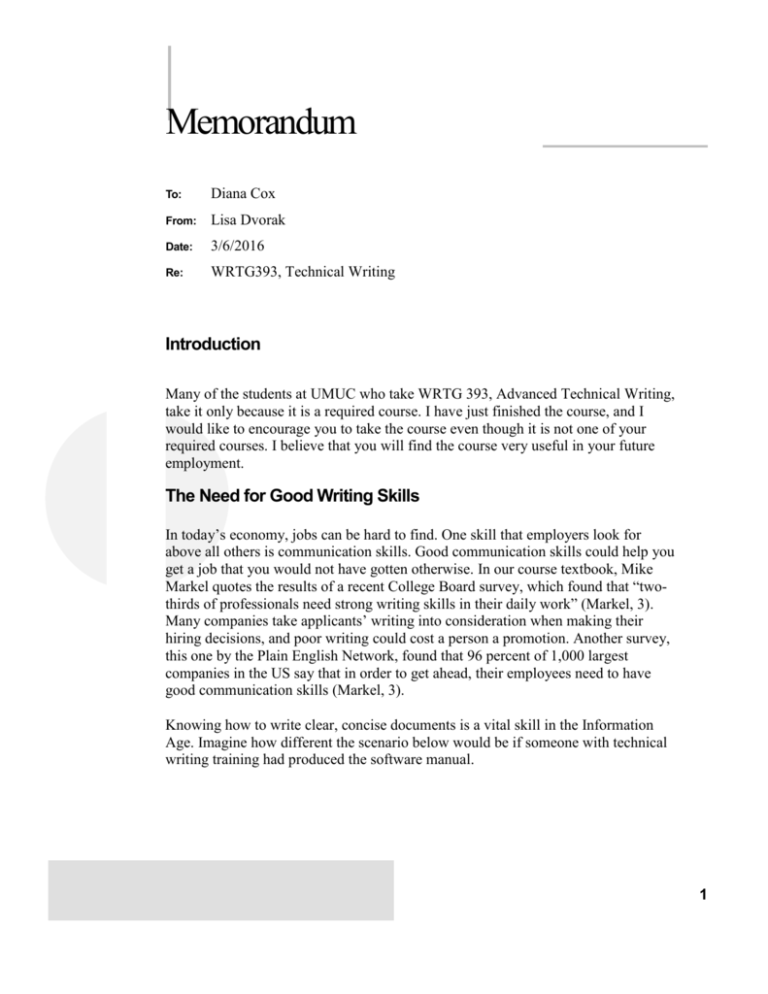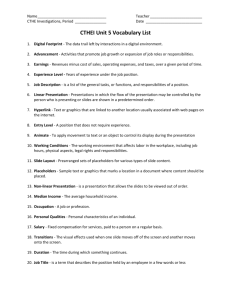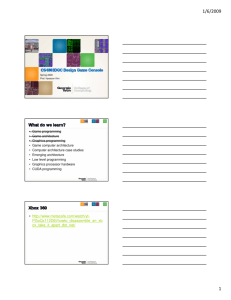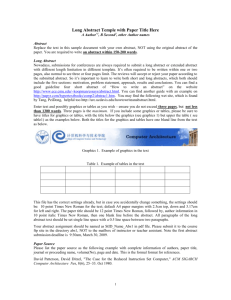Memorandum - Lisa Dvorak
advertisement

Memorandum To: Diana Cox From: Lisa Dvorak Date: 3/6/2016 Re: WRTG393, Technical Writing Introduction Many of the students at UMUC who take WRTG 393, Advanced Technical Writing, take it only because it is a required course. I have just finished the course, and I would like to encourage you to take the course even though it is not one of your required courses. I believe that you will find the course very useful in your future employment. The Need for Good Writing Skills In today’s economy, jobs can be hard to find. One skill that employers look for above all others is communication skills. Good communication skills could help you get a job that you would not have gotten otherwise. In our course textbook, Mike Markel quotes the results of a recent College Board survey, which found that “twothirds of professionals need strong writing skills in their daily work” (Markel, 3). Many companies take applicants’ writing into consideration when making their hiring decisions, and poor writing could cost a person a promotion. Another survey, this one by the Plain English Network, found that 96 percent of 1,000 largest companies in the US say that in order to get ahead, their employees need to have good communication skills (Markel, 3). Knowing how to write clear, concise documents is a vital skill in the Information Age. Imagine how different the scenario below would be if someone with technical writing training had produced the software manual. 1 Diana Cox Page 2 March 6, 2016 Fig. 1. Source: Tips for Effective Writing. Web. 20 Aug 2011. <http://alumni.twb.edu.in/index.php/tips-for-effective-writing>. To quote one of the students in my class, “...it's my opinion that it is an invaluable class that corresponds directly with the needs of a diverse and technical workforce. Students attend college to open up their futures for better opportunities and I believe this class helps them achieve it.” (Garrett) Job seekers need every skill they can get these days, and I feel that taking Advanced Technical Writing will help give you many additional skills. Legal Implications Plagiarism and copyright violations have become more and more commonplace since the Internet made information so accessible. Copyright, trademark, and patent violations are a serious issue, and could cost a company a great deal of money in fines if it violates copyright. Our Technical Writing textbook had an entire chapter about legal and ethical issues. In addition to copyright and trademark issues, we covered a writer’s ethical obligations to her employer and the public, as well as how to use the design of a document to highlight warnings and other important information. Knowing how to properly incorporate these things into a document could save you and your company from having to pay fines or worse, such as having a lawsuit filed against the company for a warning you omitted. Society is becoming more and more litigious, and every company must be careful to include any necessary warnings in its documents. Advanced Technical Writing will teach you that and much more. 2 Diana Cox Page 3 March 6, 2016 Graphics Readers prefer documents with graphics. According to Markel, people who read a document with graphics remember 43 percent more than with documents without graphics (298). When used effectively, graphics can make a point more easily and clearly than text alone. Some instances when graphics are preferable to text include: Showing logical or numerical relationships Showing spatial relationships Showing the steps in a process Writing for an international audience (Markel, 299) In all of these cases, graphics work much better than text alone. One of our writing assignments was to write an instructional manual. This was the perfect opportunity for me to practice what I had learned about using graphics in documents. I wrote a manual for someone who wanted to start working with polymer clay. Several of the steps were difficult to explain with words, but a photograph of someone performing that step showed the reader exactly what to do. Because I used graphics in this manual, I think anyone could understand the basics of using polymer clay. In the Advanced Technical Writing course, we learned how to choose the appropriate graphics for a document and the best way to incorporate them into the document. This is another skill that is rapidly becoming a vital part of any job seeker’s arsenal. I believe that almost any document could benefit from the use of graphics, and after taking this course, I feel confident in my ability to choose the correct graphics for the job. It would be wise for you to learn this as well. Conclusion I feel that you would benefit from taking Advanced Technical Writing. You would learn many valuable skills, and your writing will surely improve. Another student in my class said, “This class allows you to write as you would in the real world.” (Neeley) She is right: I have learned how to write documents for the business world, rather than writing a paper to satisfy an instructor, as is so common in college classes. This gives me an advantage over other job applicants, and taking this course would give you the same advantage. 3 Diana Cox Page 4 March 6, 2016 Works Cited Garrett, S. "Re: Instructions for "What Have We Learned" Conference." 13 August 2011. Online Posting to WebTycho Conferences, WRTG393. Web. 20 Aug 2011. Markel, Mike. Technical Communication . 9th. Boston, MA: Bedford St. Martin, 2010. 3-299. Print. Neeley, R. "Re: Instructions for "What Have We Learned" Conference." 17 August 2011. Online Posting to WebTycho Conferences, WRTG393. Web. 20 Aug 2011. 4








